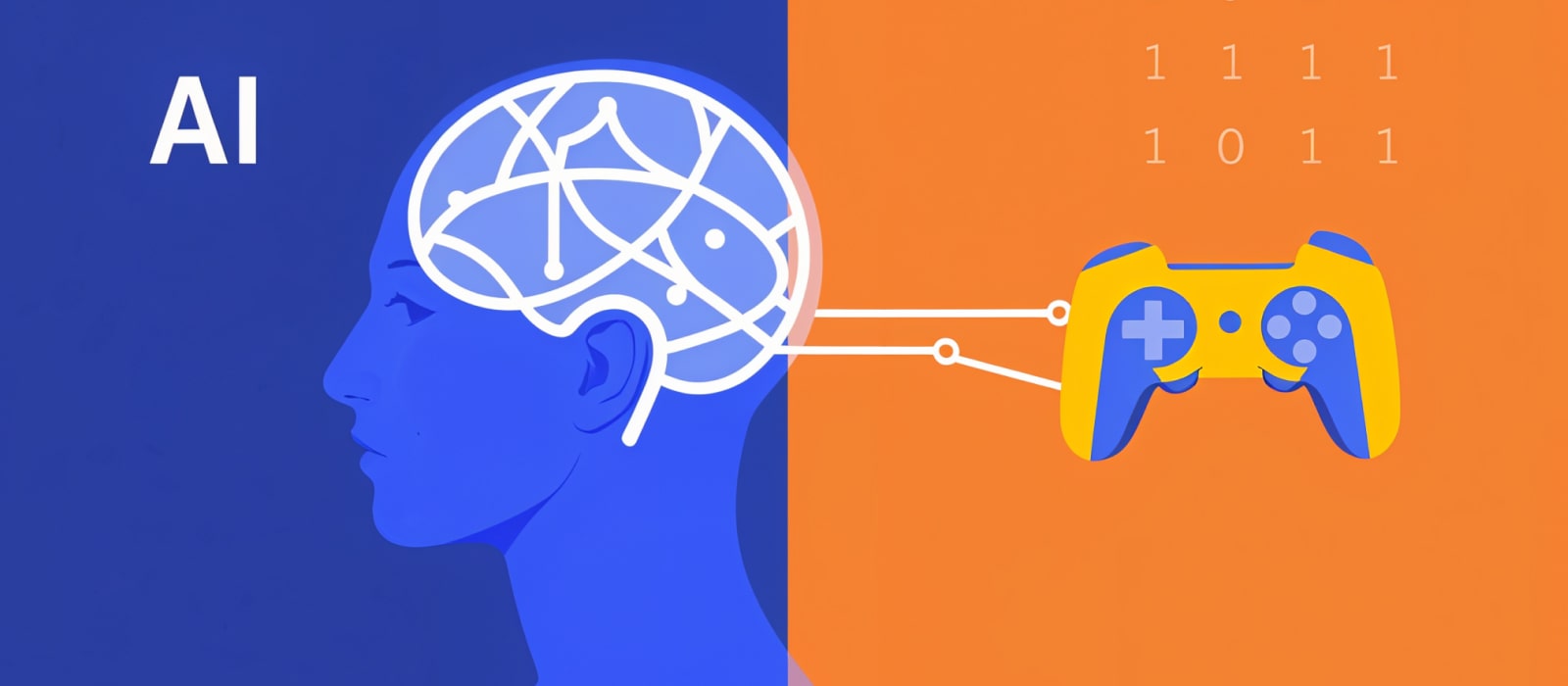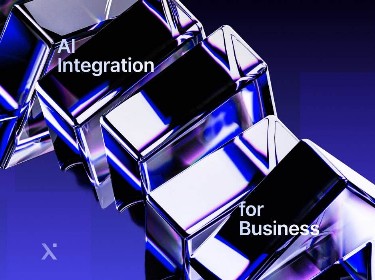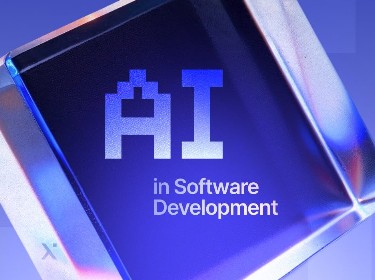AI is becoming a universal tool for game design. Despite video game artificial intelligence still being in its infancy, game companies have already started to recognize attractive benefits such as enhanced player experience and cost reduction.
Ever since the first program that played chess in the ’50s, video games have been associated with artificial intelligence. The efforts to solve the challenge of computers defeating human experts in strategy games such as chess, poker, and Go have significantly advanced AI research. In turn, this has led to enhancements in the design of new games.
In a broad sense, most video games incorporate some form of AI. Nevertheless, modern AI methods can be applied in distinct areas that help game companies realize business benefits as well. For example, through enhancing photorealistic effects, generating content, balancing in-game complexities, and providing intelligence to non-playing characters (NPCs), AI improves the overall user experience while saving game companies budget and time.
Read on to find out more about the importance and impact of AI in games, typical applications, commonly employed AI methods, the most popular games that utilize AI, the business benefits, current limitations in how AI can be applied, and the future of AI in games.
The importance and impact of AI in games
Game developers strive to deliver valuable interactive experiences to players. These experiences derive from the cumulative effects of a number of orchestrated game elements, including graphics, sounds, gameplay timing, narratives, challenges, and content that directly interacts with the players (allies, opponents, or other objects). Because of this, AI is becoming an unmatched tool that can help designers coordinate the ever-growing complexity of game dynamics.
The growing popularity of AI in games also has significant business benefits for enterprises. The gaming industry is becoming one of the most profitable sectors, with a market value predicted to reach around 314 billion USD by 2026. As a result, funding of the development of AI-based games worldwide has been steadily rising.
Today, many startups are emerging in this area. For example, latitude, a startup that develops games using AI-generated infinity storylines, raised 3.3 million USD in seed funding in January 2021. Osmo, an interactive play company, has raised 32.5 million USD in funding so far. Gosu Data Lab, another AI gaming startup based in Lithuania, has raised 5.1 million USD in funding. Gosu mainly focuses on exploring gaming data for AI purposes, helping gamers get better at playing.
Our AI development services can improve your bottom line up to 45%. See for yourself
Typical applications of AI in games
The application of AI in games is diverse; it can be used for image enhancement, automated level generation, scenarios, and stories, balancing in-game complexity, and adding intelligence to non-playing characters (NPCs).
![]()
Image enhancement
At the forefront of image enhancement are the AI engineers who are making efforts to use a deep learning system that turns 3D rendered graphics into photorealistic images. Such a system has been tested on Grand Theft Auto 5. The developed neural network is capable of recreating LA and southern Californian landscapes in great detail. The most advanced image enhancement AI algorithms can convert high-quality synthetic 3D images into real-life-like depictions.
One application of image enhancement in video games is to improve the graphics of classic games. The main idea behind the algorithms proposed for this job is to take a low-resolution image and turn it into a version that looks the same but has many more pixels. This process is called “AI upscaling”.
Game level generation
Game level generation is also known as Procedural Content Generation (PCG). These are the names for a set of methods that use advanced AI algorithms to generate large open-world environments, new game levels, and many other game assets. This is one of the most promising applications of artificial intelligence in game design. Open world or open map games include some of the most popular games to date. These games allow players to explore vast landscapes. Creating such games is very time-consuming from both the design and development perspectives. But AI algorithms can build and optimize new scenery in relation to the game’s status. For example, No Man’s Sky is an AI-based game with an infinite number of new levels generated on the fly while you play.
Scenarios and stories
AI is used to generate stories and scenarios. Most often, AI is used to create an interactive narrative. In this kind of game, users create or influence a dramatic storyline through actions or what they say. The AI programs use text analysis and generate scenarios based on previously learned storylines. AI Dungeon 2 is one of the most famous examples of this application. The game utilizes a state-of-the-art open-source text generation system built by OpenAI and trained on the Choose Your Own Adventure books.
Balancing in-game complexity
The main advantage of AI algorithms is their ability to model complex systems. Game developers are continuously trying to create more immersive and realistic games. However, modeling the real world is complex. AI algorithms can predict the future effects of gamer actions, and even model things like weather and emotions to balance in-game complexity. A real example of this application is FIFA’s ultimate team mode. FIFA automatically calculates a team chemistry score based on the personality traits of the players in a football team. Team morale oscillates from low to high based on the in-game events (losing the ball, making a well-timed pass, etc.) In this way, teams with better players can lose games against weaker teams because of their morale. In this way, AI can be used to add a layer of complexity.
Adding intelligence to non-playing characters (NPCs)
In most current games, the opponents are pre-programmed NPCs; however, AI is on the path to adding intelligence to these characters. This will make them less predictable and more enjoyable to play against. In addition, AI allows NPCs to get smarter and respond to the game conditions in novel and unique ways as the game progresses. Many gaming companies have already started working on AI-based NPCs. For example, SEED (EA) trains NPC characters by imitating the top players in games. This approach will profoundly reduce the development time of NPCs, as hard coding of their behavior is a tedious and lengthy process.
Get more insights into this blockchain battleship game powered by Echo smart contracts
AI methods used in games
Traditionally the behavior of NPCs was programmed using rule based and finite state machines. The development using these techniques involved programming many conditionals that gave NPCs deterministic behaviors. To reduce the development effort while introducing a degree of unpredictability in games, developers used fuzzy logic. One of the first uses of AI in games programming was through so-called A* pathfinding algorithms that define the behavior of NPCs and their exploration of open worlds. Other techniques include scripting, expert systems, and artificial life (A-life) approaches.
Many popular games such as Black & White, Battlecruiser 3000AD, Creatures, Dirt Track Racing, Fields of Battle, and Heavy Gear employed non deterministic methods such as decision trees, (deep) neural networks, genetic algorithms, and reinforcement learning methods. Let’s explore these techniques in detail.
Decision trees
Decision trees (DTs) are supervised learning models that can be trained to perform classification and regression. They are one of the most basic machine learning methods for game design, and can enable the value of a variable of interest to be predicted through learning simple decision rules inferred from the data features.
Decision trees are pretty simple to understand, and the results can be easily interpreted. Tree visualization techniques are also very advanced. The developed models are known as white box models and can be validated using various statistical tests.
In artificial intelligence game design, DTs are used to describe choices and consequences (predictions of actions). Most modern games use DTs, primarily narrative-based games. In one such use, decision trees can provide players with insights into how the future will look depending on their choices. For example, in Star Wars Jedi: Fallen Order, decision trees provide hints regarding the past and future of the main character if certain circumstances were to occur.
(Deep) neural networks
Artificial neural networks (NNs) are structures akin to human brains that can learn various features from training data. Given a large set of data, NNs are capable of modeling very complex real-world and game scenarios. NNs overcome some of the shortcomings of classic AI techniques in game agent design. Furthermore, NNs are self-adaptive and adapt well to game environments that change in real-time.
NN-based game agents can learn in two ways. Either they are trained before being deployed in a game (offline), or the learning process can be applied in real time during the gameplay (online). Online training allows for the creation of game agents that continuously improve while the game is being played.
NN-based agents can quickly adapt to the changing tactics of human players or other NPCs, and can make sure the game remains challenging even during extended gameplay.
Lately, Deep NN (deep learning) has become a more popular choice for game agent design. Deep learning in games utilizes multiple layers of neural networks to “progressively” extract features from the input data. Due to its layered approach and increased architectural complexity, deep NN can achieve better results when controlling one or several game agents. These agents can either be NPCs or the game environment itself.
Genetic algorithms
In the most basic terms, a genetic algorithm (GA) is a higher-level procedure, a heuristic, inspired by the theory of natural evolution. The genetic algorithm mimics the process of natural selection, where the fittest candidates are chosen to produce offspring of the next generation.
GAs are used for various optimization tasks. When compared to different optimization techniques, GAs are capable of delivering excellent results for multicriteria optimizations. In the past, GAs found their place in board games that employ various search techniques when seeking the next best moves. The most recent applications of GAs to NPCs allow adaptation of these agents to defend against effective but repetitive tactics that human players may employ. The application of GAs leads to a more realistic game experience, where human players or other AI agents cannot find loopholes and dominate the game with repeated steps that always lead to success. The end benefit of GAs is extended playability.
Reinforcement learning
Reinforcement learning (RL) is a machine learning method that is based on learning from trial and error. During training, the model is allowed to play out scenarios and learn from whether things ended well or not so well.
Reinforcement learning is effective when designing NPCs to make decisions in dynamic and unknown environments. Reinforcement learning has been used in games for a long time. Therefore, games are rich domains for testing reinforcement learning algorithms. At the same time, some of the best computer players use reinforcement learning (AlphaGo). However, the primary reinforcement learning algorithms are not sufficient for high-level game playing, so these methods are often used with other AI methods such as deep learning.
Take a look at this AI-powered retina disease diagnosis tool
Overview of popular AI-based games
There are many examples of AI applications in game design. Each of these AIs has a different level of sophistication. Here are some examples of the most highly regarded AI in the gaming industry.
![]()
F.E.A.R.
F.E.A.R. is a first-person shooter and psychological horror game in which the main player engages with robots, various creatures, and cloned supersoldiers. The game creators have developed AI that generates context-sensitive behaviors. For example, so-called Replicas can utilize the game environment to their advantage. Replicas can overturn tables to provide cover, open doors, crash through windows, or even alert the rest of their peers to the players’ actions. Additionally, game AI can perform a flank attack, put out a fire, and throw grenades to force a player out of cover.
StarCraft II
Starcraft II is a real-time strategy game where players take a seat in a 1 vs. 1, 2 vs. 2, or 3 vs. 3 battle arena. The main aim of the players is to destroy their opponents’ bases. This is done by creating units that are effective at defeating the opponents’ units. Players can choose to play against various levels of AI from easy to Cheater 3. Starcraft’s AI is capable of cheating to defeat human players by processing information about human player bases. Starcraft II as a game has also become a popular environment for AI research. In a joint push, Blizzard and DeepMind have released a public Starcraft II environment where scientists and enthusiasts can test various AI algorithms.
Alien: Isolation
Alien: Isolation is based on the Alien sci-fi horror movie series. The setting of this survival game is 15 years after the events of the movie, when Amanda Ripley, the daughter of Ellen Ripley (main character of the movie), investigates her mother’s disappearance. Game developers utilize AI to measure the amount of stress the player is experiencing. AI measures three critical elements at all times: if the Xenomorph (Alien) can be seen by the player, distance between the Xenomorph and the player, and the proximity of the Xenomorph to the motion tracker and how fast it can reach the player.
AI uses these three factors to determine the stress level that the player experiences. If the stress level is too low, it instructs the Xenomorph to move to a specific location closer to the player. If the level is too high, it moves the Xenomorph away from the player. In this way, AI creates ups and downs, a true characteristic of good horror.
Forza Horizon Series
Forza Horizon is a simulation racing game that emulates real-world racing car performance and handling characteristics. Forza employs a learning neural network in its design to control non-human drivers. The developed AI system can observe human drivers and imitate their style of driving. Under the name Drivatar, this AI system has recently been connected to Microsoft’s cloud services, from which it gets driving data from a vast number of human racers. This data is used to create AI systems that mimic other players from around the world, not just their strengths but also their weaknesses, to provide unpredictable experiences for the competing human drivers.
The business benefits of using AI in games
AI brings a number of business benefits for game development companies. Companies that use AI in their games can save budget and time, provide a better user experience, and streamline their development processes.
![]()
Save budget and time
The gaming industry is one of those industries where a lot of budget and time are invested in development, i.e. while developing a game. In addition, there is always a risk that the audience may not accept the game. To avoid this, before a game is released to the market, it requires stringent QA software testing services and focus-group testing. As a result, a single game development process for a sophisticated game can sometimes take years.
AI is an indispensable tool allowing game companies to drastically reduce time and development budgets. When used for automated level generation, AI can save thousands of hours of development work. Furthermore, by employing data-driven techniques instead of hard-coded rules, AI eliminates the manual labor that would need to be invested otherwise. As a result, delivery costs can be reduced dramatically, meaning that game companies can hire better game developers to finish the job. This advantage is becoming increasingly important in a highly competitive job market for developers.
Better user experience
In the gaming business, the end-user experience is a critical success metric. User experience is an integrative component of the gaming business that determines sales volume, loyalty levels, marketing success, and many other business factors.
AI can make a game appear more sophisticated and realistic, sparking gamers’ interest in playing and likelihood to recommend the game to others. For example, AI voice intelligence helps players understand their in-game actions better. It adds another level to the overall user experience by smartly engaging players’ senses.
Another aspect of user experience that AI is enhancing is adaptation. For example, AI can make use of large amounts of personalized and privacy-protected data to create scenarios that certain types of gamers will enjoy the most.
Streamlined processes
The streamlined process has fewer errors and delays. Game AI assists developers by automatically generating content such as landscapes, levels, items, quests, and music. Once the AI development process is set in stone, human errors are removed from the picture. Delays in development can also be eliminated due to AI being very efficient at dedicated tasks.
Find out more about this smart retail solution powered by AI & iBeacon technology
Limitations in the use of AI in games
The applications of artificial intelligence in games have certain limitations. It is, for example, difficult to design realistic NPC enemies that can automatically produce an engaging level for each individual. AI-based NPC enemies are usually intended to respond in the best way to a player’s moves. Such components are unbeatable but also predictable and quickly cease being fun.
![]()
Due to the ability of AI to predict possible future outcomes, AI can quickly become unbeatable. A famous example of such a scenario is a Tic-Tac-Toe game where AI implements a minimax algorithm that can lead to drawn games regardless of which move the human makes.
AI is often allowed to cheat when trying to defeat humans. The need to cheat, however, reveals the limits to achievable artificial intelligence. In games that require strategy and creativity, humans are generally able to beat AI. Since game artificial intelligence can still not learn from its own mistakes, the use of AI in such games is minimal.
Another limitation of artificial intelligence that does not only apply to gaming is the lack of context outside the training data. Again, this leads to ethical considerations and biases.
These limitations affect only a small set of game AI applications. The AI field is undergoing continuous improvement, and it’s likely that very soon these challenges will be successfully tackled.
Future of artificial intelligence games
The impact of AI in the gaming industry is expected to grow even further with new possibilities such as autonomous character evolution, learning, and adaptation. The main idea is to design games with agents that are not static but continually evolve as the game is played. Future NPCs will be able to evolve during gameplay, and it will become more difficult for a player to predict their behaviors. With increasing gameplay time, AI-backed games will become more advanced and challenging for players to predict. As a result, the play-life of the games will be profoundly extended. AI techniques enabling these opportunities will also grow in sophistication.
AI that utilizes machine learning will need a vast amount of training data to be successful. Currently, there is a general lack of training data. However, as more companies realize the importance of AI and data, this limitation will fall away.
The ultimate goal of AI in games is to offer infinite combinations of stories, landscapes, and levels as well as realistic NPCs and endless customization.
The development of AI for gaming requires deep knowledge and practical experience. We at PixelPlex have both; our AI development services span both custom software development services and existing solution revamping. We can also enhance your gaming experiences with:
- Real-time data analytics for adaptive gameplay
- IoT development
- ML-driven game level generation
Whether you’re building a sophisticated single-player title or diving into tokenized ecosystems, choosing a trusted web3 game development agency will ensure your game leverages cutting-edge AI.
Drop us a line and let’s discuss your trailblazing project today!




